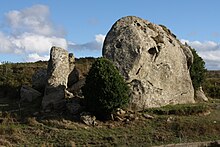Argimusco

The Argimusco is a high plateau situated just north of Mount Etna in Sicily, Southern Italy, between the Nebrodi and Peloritani Mountains. It is located within the boundaries of the communes of Roccella Valdemone, Tripi, and Montalbano Elicona, the latter of which was constructed on the site of the prehistoric Abaca Enum. The location provides a comprehensive view of the Aeolian Islands, the Rocca Salvatesta and Montagna di Vernà mountains, cape Tindari, cape Calavà, and cape Milazzo.
Argimusco, the sicilian Stonehenge
Between Montalbano Elicona, Novara di Sicilia and Tripi, in the province of Messina, on the northern borders of the Bosco di Malabotta, a group of large quartz sandstone rocks, with curious and evocative shapes, rises over a thousand metres above sea level. On one side the Tyrrhenian Sea, on the other the valley of the Alcantara river.
Examples of names for the stones are, Virgin in prayer, the monk, the male face or the eagle.
Its atmosphere has been compared to the British Stonehenge.
There are multiple hypotheses what the megaliths of Argimusco were: a site for sacred rites, a place for astronomical observations for the people of antiquity, or sandstone rocks eroded over the centuries by the wind of the plateau.
Even today, eleven constellations are reflected in the megaliths of the site after sunset on cloudless summer evenings.[1]
The Rocks
According to local legend, the dolmens and ancient menhirs are megaliths from a prehistoric population. The widespread belief is that wind erosion causes these.
Two sizable, elongated stones stand among the megaliths in Portella Cerasa, and another megalith bears an etched Sun symbol. A large boulder in front of the dolmen's remnants at Portella Zilla, further to the west, may have been a menhir that had collapsed. Around the alleged monuments, no evidence of prehistoric human habitation, such as pottery, tools, or bones, have been discovered.
The Eagle
The Eagle is formed by the overlapping of blocks from the pentagonal faces. The megalith is a bird of prey, with wings half-spread and the head facing south. The eagle in hermetic symbolism is a privileged being which connects earth with heaven. It is the symbol of the soul of the deceased. The latter after the death of material life is born to new life (like the alchemical phoenix rising from the ashes, the soul rises from the alchemical ashes). In the background of the Aquila, stands Mount Nettuno (Rocca Salvatesta) that probably in the economy of the site acts as solstice or equinox indicator.[2]

The Alchemical symbols
On Argimusco, the statues of the Pelican, the Owl, and finally a rock that resembles the alchemical alembic have been found.


The Profile of Asclepius
On the wall facing west, you notice the haughty profile of a young man who looks with his face upwards to the setting sun. The dual representation suggests the chthonic Italian deity of Janus, then adopted in Roman religion, to whom is dedicated the month of starting of the year. With it were measured various passages of the sun on the solstices on the north-south diagonal. In fact, the Great Cliff of Janus plays a central role in any relationship north (Aeolian Islands) and south (Etna).

Virgo (Constellation)
If we with a look towards the west, we can admire the incredible precision, almost "portrait", of the megalith of the ‘Praying Woman’ or ‘Virgo". It is a mysterious androgynous figure twenty-six meters high with her hands clasped in prayer. You notice the elbow, the mantle, the knee, the Phrygian cap on the head, and even the pedestal base.
Ritual Ablution
The Virgin is the center of the "Mirror of the stars" staged at Argimusco, since all other figures play an ancillary role with respect to it. As a matter of fact, the sun rises in Virgo at summer solstice of 10,500 BC. It embodies the feminine divine figure, which is lunar liquid mercury, as opposed to the divine Apollonian, masculine, solar disk, put in alchemical terms. As a mercurial element, it is precisely located near the Serpens constellation and the bearer of snakes (Ophiuchus), or the symbol of the Caduceus of Hermes (Mercury) consisting of a rod around which wraps themselves, in fact, two snakes (now the symbol of medicine). Particularly significant, high on the megalith of the Virgo is a rectangular pool, that we suppose was used for ritual ablutions.
Gallery
References
- ^ Mannarano, Ignazio (2015-10-06). "Argimusco, the Sicilian Stonehenge". Visit Sicily. Retrieved 2023-04-17.
- ^ "L'Argimusco, Sicily's own Neolithic mystery site". Times of Malta. Retrieved 2022-04-26.
Sources
- Devins, Paul; Musco, Alessandro (2014). Argimusco Decoded.
- Devins, Paul (2011). La Scoperta di Argimusco.
- Devins, Paul (2010). Il Mistero dell'Argimusco.










